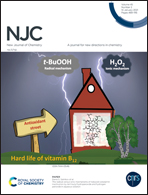A low-cost asymmetric carbazole-based hole-transporting material for efficient perovskite solar cells†
Abstract
Perovskite solar cells (PSCs) have reached their highest efficiency with the state-of-the-art hole-transporting material (HTM) spiro-OMeTAD. However, the relatively low conductivity and high cost of this material significantly limit the commercialization of this promising technology. In this work, a low-cost, asymmetric HTM containing a carbazole core and peripheral triphenylamine moieties, named Cz-3OMeTAD, was designed and synthesized via a facile three-step synthetic procedure and employed successfully in planar CH3NH3PbI3 PSCs. The optical and electrochemical data of the asymmetric HTM Cz-3OMeTAD exhibited appropriate energy levels for efficient interfacial charge transfer with the perovskite. The asymmetric propeller-shaped Cz-3OMeTAD has a relatively high mobility value of 1.42 × 10−3 cm2 V−1 s−1, beneficial for the PSC performance. Moreover, steady-state PL and time-resolved PL measurements indicate successful hole extraction properties of Cz-3OMeTAD from the perovskite at the perovskite/HTM interface. Consequently, the Cz-3OMeTAD-based devices achieved a high efficiency of 16.36% in PSCs under 1 sun conditions, comparable with the efficiency obtained for the reference cell using spiro-OMeTAD. Thus, our result demonstrated the asymmetric carbazole-based material as a new class of HTM for highly efficient PSCs.



 Please wait while we load your content...
Please wait while we load your content...